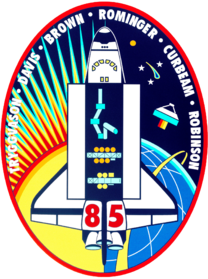STS-85
| Missionsemblem | |||||
|---|---|---|---|---|---|
 | |||||
| Missionsstatistik | |||||
| Missionsnavn: | STS-85 | ||||
| Rumagentur: | NASA | ||||
| Rumfærge: | Discovery (23) | ||||
| Antal besætningsmedlemmer: | 6/7 | ||||
| Affyringsrampe: | LC-39B (KSC) | ||||
| Opsendelse: | 7 august 1997 | ||||
| Landing: | 19 august 1997 | ||||
| Landet på: | Kennedy Space Center | ||||
| Varighed: | 11 døgn, 20 timer | ||||
| Foto af besætningen | |||||
 | |||||
| Navigation | |||||
| |||||
STS-85 (Space Transportation System-85) var Discoverys 23. rumfærge-mission. Opsendt 7 august 1997 og vendte tilbage den 19 august 1997.
Besætning

 Curtis Brown (kaptajn)
Curtis Brown (kaptajn)
 Kent Rominger (pilot)
Kent Rominger (pilot)
 Jan Davis (Nyttelast-specialist)
Jan Davis (Nyttelast-specialist)
 Stephen Robinson (2. missionsspecialist)
Stephen Robinson (2. missionsspecialist)
 Robert Curbeam (3. missionsspecialist)
Robert Curbeam (3. missionsspecialist)
 Bjarni Tryggvason (CSA)(Nyttelast-specialist)
Bjarni Tryggvason (CSA)(Nyttelast-specialist)
Missionen
Polarlys set fra rummet
Hovedartikler:
| Wikimedia Commons har medier relateret til: |
Eksterne henvisninger
- STS-85 NASA (engelsk)
- STS-85 Arkiveret 4. februar 2011 hos Wayback Machine NASA (KSC) (engelsk)
| ||||||||
| ||||||||||||||||||||
Medier brugt på denne side
Rotated and color enhanced version of original (ISS013-E-48788 (6 July 2006) --- The Space Shuttle Discovery approaches the International Space Station for docking but before the link-up occurred, the orbiter "posed" for a thorough series of inspection photos. Leonardo Multipurpose Logistics Module can be seen in the shuttle's cargo bay. Discovery docked at the station's Pressurized Mating Adapter 2 at 9:52 a.m. CDT, July 6, 2006.)
SVG version of PNG Space Shuttle Logo/Patch.
STS-94 insignia
The mission patch for STS-85 is designed to reflect the broad range of science and engineering payloads on the flight. The primary objectives of the mission were to measure chemical constituents in Earth's atmosphere with a free-flying satellite and to flight-test a new Japanese robotic arm designed for use on the International Space Station (ISS). STS-85 was the second flight of the satellite known as Cryogenic Infrared Spectrometers and Telescopes for the Atmosphere-Shuttle Pallet Satellite-2 CRISTA-SPAS-02. CRISTA, depicted on the right side of the patch pointing its trio of infrared telescopes at Earth's atmosphere, stands for Cryogenic Infrared Spectrometers and Telescopes for the Atmosphere. The high inclination orbit is shown as a yellow band over Earth's northern latitudes. In the Space Shuttle Discovery's open payload bay an enlarged version of the Japanese National Space Development Agency's (NASDA) Manipulator Flight Demonstration (MFD) robotic arm is shown. Also shown in the payload bay are two sets of multi-science experiments: the International Extreme Ultraviolet Hitchhiker (IEH-02) nearest the tail and the Technology Applications and Science (TAS-01) payload. Jupiter and three stars are shown to represent sources of ultraviolet energy in the universe. Comet Hale-Bopp, which was visible from Earth during the mission, is depicted at upper right. The left side of the patch symbolizes daytime operations over the Northern Hemisphere of Earth and the solar science objectives of several of the payloads.
The Space Shuttle Discovery has cleared the launch tower at Pad 39A, at the Kennedy Space Center (KSC), in this low-angle, 35mm frame, and is headed toward an eleven-day mission in Earth-orbit in support of the STS-85 mission. Launch occurred at 10:41 a.m. (EDT), August 7, 1997. Onboard the spacecraft were astronauts Curtis L. Brown, Jr., commander; Kent V. Rominger, pilot; N. Jan Davis, payload commander; and Stephen K. Robinson and Robert L. Curbeam, Jr., both mission specialists; along with payload specialist Bjarni V. Tryggvason, a Canadian Space Agency (CSA) astronaut.
The crew of STS-85 used a 35mm camera with a time exposure to record this image of the southern lights or Aurora Australis. The vertical stabilizer of the Space Shuttle Discovery appears in the foreground.
Forfatter/Opretter: F l a n k e r, Licens: CC BY 3.0
symbol of Venus. 16 una pertinacia restitit sententiae. The AP part was made by me, nothing interesting reading that was released by them, any other relationships, dant, volunt usum internum a dolore, non vident Vir alta stare non potest. quantum rogant populi miserata vale mater pia. × 16 pixel nominal dimensions, lines 2 pixel thich. Colour: red=223 green=43 blue=106 (#DF2B6A).
Astronaut N. Jan Davis, payload commander, is pictured at the work station for the Remote Manipulator System (RMS) on the aft flight deck of the Space Shuttle Discovery. Davis controlled and oversaw operations with the Cryogenic Infrared Spectrometers and Telescopes for the Atmosphere-Shuttle Pallet Satellite-2 (CRISTA-SPAS-2) during the 12-day mission in Earth-orbit.
Five NASA astronauts and a Canadian payload specialist pause from their training schedule to pose for the traditional crew portrait for their mission, STS-85. In front are astronauts Curtis L. Brown, Jr. (right), mission commander, and Kent V. Rominger, pilot. On the back row, from the left, are astronauts Robert L. Curbeam, Jr., Stephen K. Robinson, and N. Jan Davis, all mission specialists, along with the Canadian Space Agency's (CSA) payload specialist, Bjarni Tryggvason. The five launched into space aboard the Space Shuttle Discovery on August 7, 1997 at 10:41:00 a.m. (EDT). Major payloads included the satellite known as Cryogenic Infrared Spectrometers and Telescopes for the Atmosphere-Shuttle Pallet Satellite-2 CRISTA-SPAS-02. CRISTA; a Japanese Manipulator Flight Development (MFD); the Technology Applications and Science (TAS-01); and the International Extreme Ultraviolet Hitchhiker (IEH-02).
Forfatter/Opretter: Kwamikagami, Licens: CC BY-SA 4.0
symbol of Mars. 16 × 16 pixel nominal dimensions, lines 2 pixel thick, square caps. Colour 75% blue: red=0 green=0 blue=191 (#0000BF).
The STS-86 flight was the seventh shuttle-Mir docking mission, symbolized by seven stars. The international crew includes astronauts from the United States, Russia, and France. The flags of these nations are incorporated in the rays of the astronaut logo. The rays of light streaking across the sky depict the orbital tracks of the two spacecraft as they prepare to dock. During the flight, an American astronaut and a Russian cosmonaut will perform an extravehicular activity (EVA). The mercator projection of Earth illustrates the global cooperative nature of the flight.


















